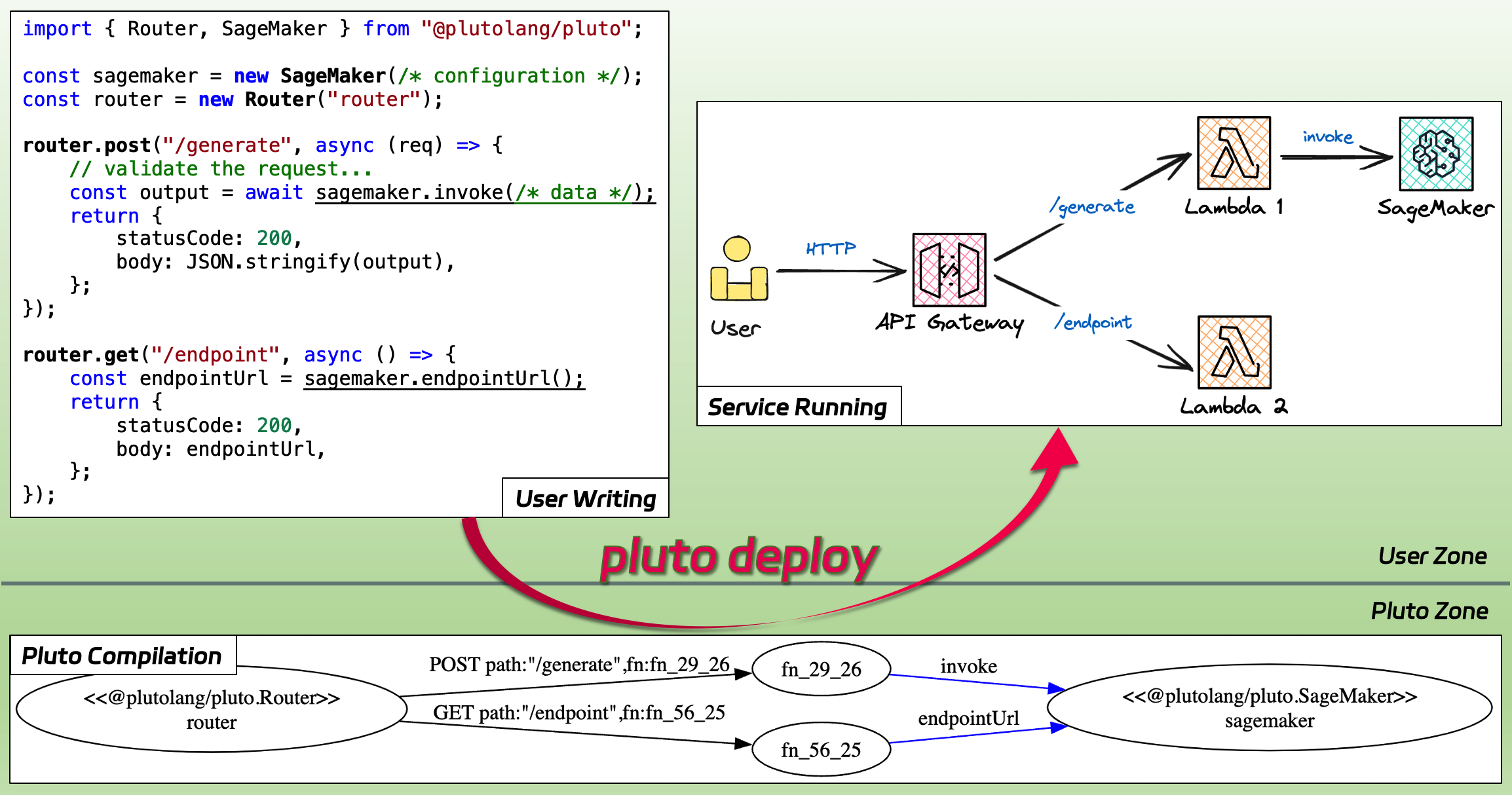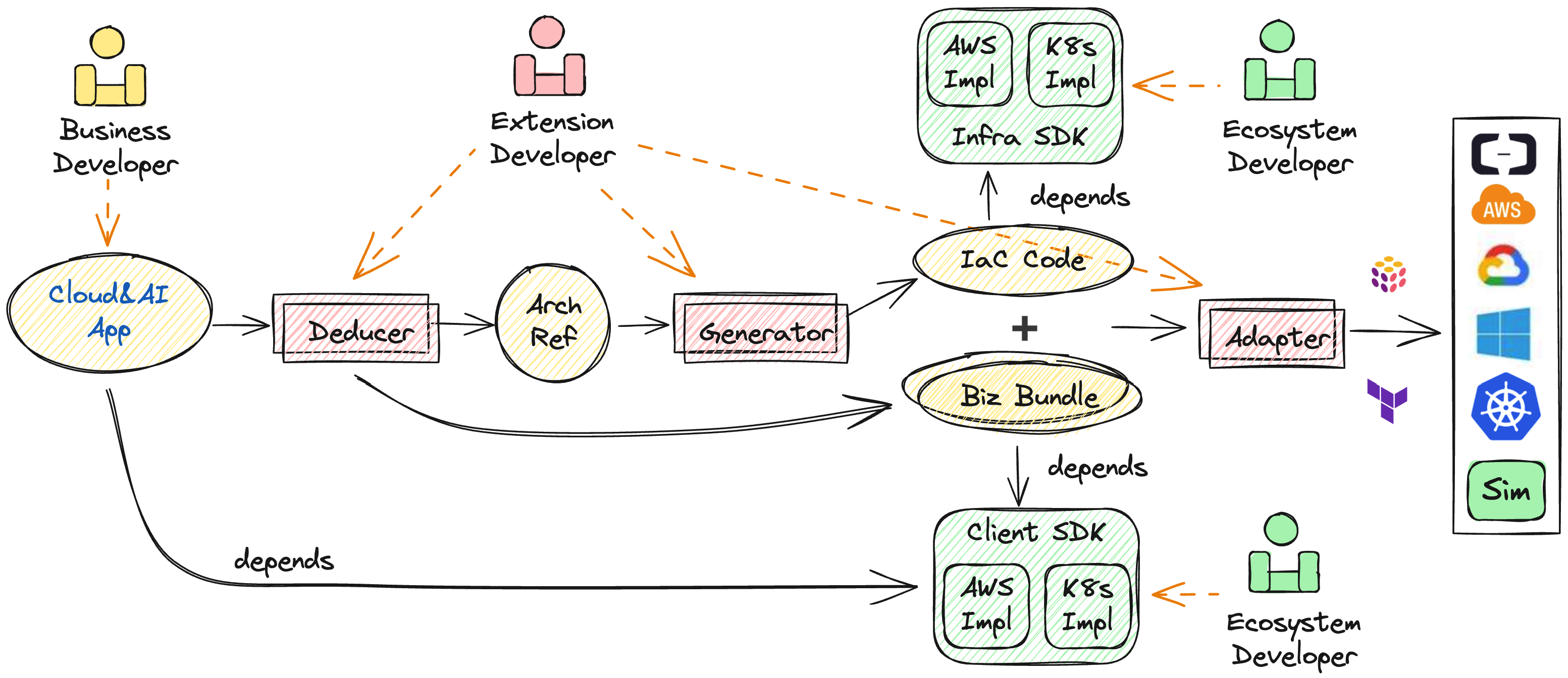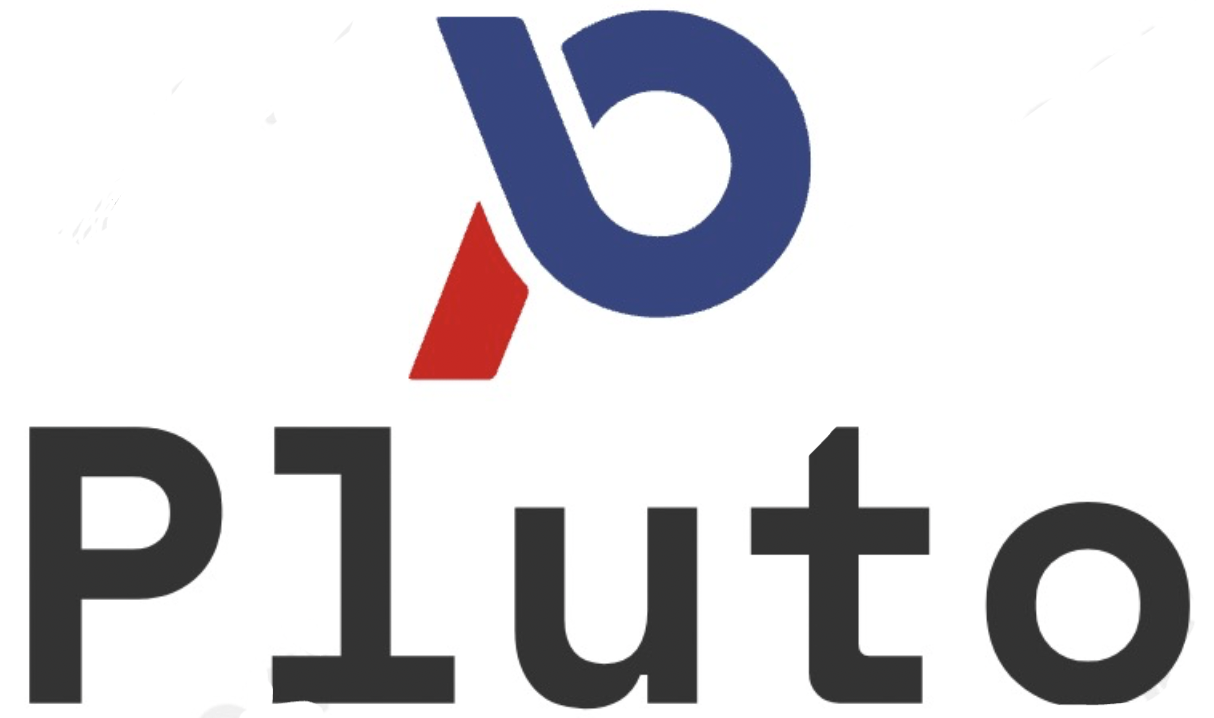Pluto is a development tool dedicated to helping developers build cloud and AI applications more conveniently, resolving issues such as the challenging deployment of AI applications and open-source models.
Developers are able to write applications in familiar programming languages like Python and TypeScript, directly defining and utilizing the cloud resources necessary for the application within their code base, such as AWS SageMaker, DynamoDB, and more. Pluto automatically deduces the infrastructure resource needs of the app through static program analysis and proceeds to create these resources on the specified cloud platform, simplifying the resources creation and application deployment process.
⚠️ Caution: Pluto is still in its early stages, please consider it for production environments with caution.
🌟 Example
Let's develop a text generation application based on GPT2, where the user input is processed by the GPT2 model to generate and return text. Below is how the development process with Pluto looks:

AWS SageMaker is utilized as the model deployment platform, and AWS Api Gateway and Lambda support the application's HTTP services. The deployed application architecture, as shown in the top right graphic ↗️, comprises two route handling functions: one to receive user input, invoke the SageMaker model, and return generated text, and another to provide the endpoint URL of the SageMaker model.
The top left graphic ↖️ captures a fragment of the application code, with the complete code accessible here (opens in a new tab). In the TypeScript code development process using Pluto, by creating a new SageMaker instance using new SageMaker(), you can directly interact with the SageMaker model using methods like sagemaker.invoke() and obtain the model endpoint URL using sagemaker.endpointUrl(). Establishing an Api Gateway requires only creating a new variable router with new Router(), and the function arguments within the methods of router, such as router.get(), router.post(), etc., will automatically be converted into Lambda functions. The same application could be implemented in Python as well.
Once the application code has been written, executing pluto deploy allows Pluto to deduce the application's infrastructure needs and automatically provision around 30 cloud resources, which includes instances such as SageMaker, Lambda, Api Gateway, along with setups like triggers, IAM roles, and policy permissions.
Finally, Pluto hands back the URL of the Api Gateway, providing direct access to use the application.
Interested in exploring more examples?
- TypeScript applications:
- Python applications:
🚀 Quick Start
Online Experience: CodeSandbox (opens in a new tab) provides an online development environment. We have constructed Pluto templates in both Python (opens in a new tab) and TypeScript (opens in a new tab) languages on this platform, allowing direct experience in the browser. After opening the project template, creating your own project is as easy as clicking the Fork button in the top right corner. The environment is pre-equipped with AWS CLI, Pulumi, and Pluto's basic dependencies, adhering to the README for operations.
Container Experience: We offer a container
image plutolang/pluto:latest for application development, which contains
essential dependencies like AWS CLI, Pulumi, and Pluto, along with Node.js 20.x
and Python 3.10 environments pre-configured. If you are interested in developing
only TypeScript applications, you can use the
plutolang/pluto:latest-typescript image. You can partake in Pluto development
within a container using the following command:
docker run -it --name pluto-app plutolang/pluto:latest bashLocal Experience: For local use, please follow these steps for setup:
Install Pulumi
Pluto operates within a Node.js environment and uses Pulumi for interaction with cloud platforms (AWS or K8s). You can refer to the Pulumi installation guide (opens in a new tab).
Install Pluto
npm install -g @plutolang/cliCreate your application with Pluto
You can use Pluto to develop applications in Python or TypeScript languages. Here's a simple example:
# 1. Create a Pluto project
pluto new -l python # Interactively create a new project
cd <project_dir>
# 2. Install dependencies
npm install
pip install -r requirements.txtOnce the project setup is complete, you can start developing your application code within the app/main.py file using your preferred editor.
Ready to Go!
Deploy with one click!
pluto deployPluto attempts to read your AWS configuration file to acquire the default AWS Region, or alternatively, tries to fetch it from the environment variable AWS_REGION. Deployment will fail if neither is set.
For detailed steps, refer to the Getting Started Guide.
Currently, Pluto only supports single-file configurations. Inside each handler function, access is provided to literal constants and plain functions outside of the handler's scope; however, Python allows direct access to classes, interfaces, etc., outside of the scope, whereas TypeScript requires encapsulating these within functions for access.
🤯 Pain Points
Here you can find out why Pluto was created. To put it simply, we aim to address several pain points you might often encounter:
- High learning curve: Developing a cloud application requires mastery of both the business and infrastructure skills, and it often demands significant efforts in testing and debugging. Thus, developers spend a considerable amount of energy on aspects beyond writing the core business logic.
- High cognitive load: With cloud service providers offering hundreds of capabilities and Kubernetes offering nearly limitless possibilities, average developers often lack a deep understanding of cloud infrastructure, making it challenging to choose the proper architecture for their particular needs.
- Poor programming experience: Developers must maintain separate codebases for infrastructure and business logic or intertwine infrastructure configuration within the business logic, leading to a sub-optimal programming experience that falls short of the simplicity of creating a local standalone program.
- Vendor lock-in: Coding for a specific cloud provider can lead to poor flexibility in the resulting code. When it becomes necessary to migrate to another cloud platform due to cost or other factors, adapting the existing code to the new environment can require substantial changes.
💡 Features
- No learning curve: The programming interface is fully compatible with TypeScript, Python, and supports the majority of dependency libraries such as LangChain, LangServe, FastAPI, etc.
- Focus on pure business logic: Developers only need to write the business logic. Pluto, via static analysis, automatically deduces the infrastructure requirements of the application.
- One-click cloud deployment: The CLI provides basic capabilities such as compilation and deployment. Beyond coding and basic configuration, everything else is handled automatically by Pluto.
- Support for various runtime environments: With a unified abstraction based on the SDK, it allows developers to migrate between different runtime environments without altering the source code.
🔧 How Does Pluto Work?

Overall, the Pluto deployment process comprises three stages—deduction, generation, and deployment:
- Deduction Phase: The deducer analyzes the application code to derive the required cloud resources and their interdependencies, resulting in an architecture reference. It also splits user business code into business modules, which, along with the dependent SDK, form the business bundle.
- Generation Phase: The generator creates IaC code that is independent of user code, guided by the architecture reference.
- Deployment Phase: Depending on the IaC code type, Pluto invokes the corresponding adapter, which, in turn, works with the respective IaC engine to execute the IaC code, managing infrastructure configuration and application deployment.
Components such as the deducer, generator, and adapter are extendable, which allows support for a broader range of programming languages and platform integration methods. Currently, Pluto provides deducers for Python (opens in a new tab) and TypeScript (opens in a new tab), and a generator (opens in a new tab) and adapter (opens in a new tab) for Pulumi. Learn more about Pluto's processes in detail in this document.
🤔️ Differences from Other Projects?
Pluto distinguishes itself from other offerings by leveraging static program analysis techniques to infer resource dependencies directly from application code and generate infrastructure code that remains separate from business logic. This approach ensures infrastructure configuration does not intrude into business logic, providing developers with a development experience free from infrastructure concerns.
- Compared to BaaS (Backend as a Service) products like Supabase or Appwrite, Pluto assists developers in creating the necessary infrastructure environment within their own cloud account, rather than offering managed components.
- Differing from PaaS (Platform as a Service) offerings like Fly.io, Render, Heroku, or LeptonAI, Pluto does not handle application hosting. Instead, it compiles application into finely-grained compute modules, and integrates with rich cloud platform capabilities like FaaS, GPU instances, and message queues, enabling deployment to cloud platforms without requiring developers to write extra configurations.
- In contrast to scaffolding tools such as the Serverless Framework or Serverless Devs, Pluto does not impose an application programming framework specific to particular cloud providers or frameworks, but instead offers a uniform programming interface.
- Unlike IfC (Infrastructure from Code) products based purely on annotations like Klotho, Pluto infers resource dependencies directly from user code, eliminating the need for extra annotations.
- Different from other IfC products that rely on dynamic analysis, like Shuttle, Nitric, and Winglang, Pluto employs static program analysis to identify application resource dependencies, generating independent infrastructure code without having to execute user code.
You can learn more about the differences with other projects in this document.
👏 Contributing
Pluto is still in its infancy, and we warmly welcome contributions from those who are interested. Any suggestions or ideas about the issues Pluto aims to solve, the features it offers, or its code implementation can be shared and contributed to the community. Please refer to our project contribution guide for more information.
🐎 Roadmap
- Complete implementation of the resource static deduction process
- 🚧 Resource type checking
- ❌ Conversion of local variables into cloud resources
- SDK development
- 🚧 Client SDK development
- 🚧 Infra SDK development
- ❌ Support for additional resources and more platforms
- Engine extension support
- 🚧 Pulumi
- ❌ Terraform
- 🚧 Local simulation and testing functionality
Please see the Issue list (opens in a new tab) for further details.
📊 Capability Matrix
✅: Indicates that all user-visible interfaces are available
🚧: Indicates that some of the user-visible interfaces are available
❌: Indicates not yet supported
TypeScript
| Resource Type | AWS | Kubernetes | Alibaba Cloud | Simulation |
|---|---|---|---|---|
| Router | ✅ | 🚧 | 🚧 | 🚧 |
| Queue | ✅ | ✅ | ❌ | ✅ |
| KVStore | ✅ | ✅ | ❌ | ✅ |
| Function | ✅ | ✅ | ✅ | ✅ |
| Schedule | ✅ | ✅ | ❌ | ❌ |
| Tester | ✅ | ❌ | ❌ | ✅ |
| SageMaker | ✅ | ❌ | ❌ | ❌ |
Python
| Resource Type | AWS | Kubernetes | Alibaba Cloud | Simulation |
|---|---|---|---|---|
| Router | ✅ | ❌ | ❌ | ❌ |
| Queue | ✅ | ❌ | ❌ | ❌ |
| KVStore | ✅ | ❌ | ❌ | ❌ |
| Function | ✅ | ❌ | ❌ | ❌ |
| Schedule | ✅ | ❌ | ❌ | ❌ |
| Tester | ❌ | ❌ | ❌ | ❌ |
| SageMaker | ✅ | ❌ | ❌ | ❌ |
💬 Community
Join our Slack (opens in a new tab) community to communicate and contribute ideas.




